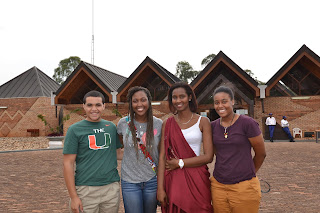The group started the day relatively early in order to get to the Rwandan National Ethnographic Museum located in Butare. We were greeted by a large group of the staff, which included Alphonse who is the director of the Museum. He was quite an eccentric man, who had British accent as a result of him fleeing to the United Kingdom during the 1994 Genocide. Alphonse informed us that the Museum had 7 galleries, which varied from Stone Age technology to clothing and games. The first exhibit that I visited was about Rwanda’s geography and featured an interesting topographic which showcased why Rwanda is called the land of one thousand hills. The temporary exhibit at the museum was also very interesting. Our tour guide explained to us that Rwanda went from the Stone Age straight to the Iron Age while skipping the Bronze Age completely. I found the early version of the umbrella that was on display to be especially fascinating. The umbrella was shaped like a large cone but with half of it hollowed out so that someone could fit in it. The umbrella protected the wearer from the rain while still leaving both hands free. My favorite future of the museum was either the the glass case that displayed Rwandan money from the past century or the room that showcased the 120 different spears used in precolonial Rwanda. These Rwamukire (ritual spears) were called the "axes of justice." They were displayed by the King's palace so that all who entered passed first through the "trees of blessing" and then under the spears, as if taking an "oath of truth." We also learned that in Rwanda, the drum played a central role in determining the leader of the people. While it is common amongst African societies for leadership to be associated with a stool, here, the drum is the most central marker of authority. Our new and good friend John, who has been with us since Zanzibar, was also able to point out a picture that included his father who was part of the Tutsi elite before the 1959 massacre.
We ate lunch at a charming little restaurant that had been converted from a house. Lunch was served buffet style, which included dishes of skewered lamb, potatoes, and salad. Following lunch, we took a short walk down to a lake where we saw multiple types of birds. We then took a bus ride to the Kings Palace, where we saw the traditional buildings where Kings and their wives would live. We were all very excited to visit the Inyambo, or Royal Cattle, which were all very majestic in their own way. Each of the individual cows has their own songs which when sung by the caretaker would result in a certain member of the cattle mooing loudly followed by a lazy trot forward. We were then taken to the first palace in Rwanda, which was built to fit the western idea of a king’s residence. Most of the furniture in the palace was original and quite stylish for each of their age. Our two-hour return trip back to Kigali allowed us more time to take in the beautiful rolling hills of the Rwandan countryside, which are similar to the ones of Tuscany. We had dinner at restaurant called Bourbon where I was able to enjoy a cup of a white chocolate mocha. Our classes continue to be robust and informative; tonight we discussed an article that explores "congruence theory" in relation to gender. Overall, I enjoyed a day that was full of learning, which was supplemented by the tasty cuisine on the side.
(p.s. there is another new post below)
 |
| Look at the crack in the sidewalk I found! It looks like Africa! |
  |
| yummy dinner after a fun day--one only a few meals we ate inside the whole trip! |











No comments:
Post a Comment